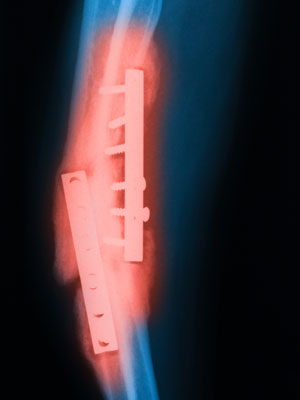
The majority of fractures (broken bones) do not lead to infections. When infections do occur after fractures, the treatment and recovery can be prolonged and complicated.
CAUSE
Infections typically occur in fractures because bacteria enter the body during the traumatic event. Although uncommon, bacteria can also enter the body during surgery to set the broken bones.
OPEN FRACTURES
If the bone breaks in such a way that bone fragments stick out through the skin or a wound penetrates down to the broken bone, the fracture is called an “open” or compound fracture. The skin is normally a barrier to outside contaminants, including bacteria. However, when the skin is broken, bacteria can easily travel down to the broken bone and possibly cause an infection.
SURGERY
During surgery to fix a fracture, the skin and soft tissues are cut in order to reach the broken bone. The risk for developing an infection in this setting is quite low, usually less than 1% in healthy individuals. Preventative antibiotics are given to patients prior to surgery and high standard of care in Operating Theater help prevent infection.
RISK FACTORS
In general, the greater the damage is to the surrounding skin, muscles, arteries, and veins near the fracture site, the higher the risk for infection.
Chronic diseases that lower your immune system may put you at greater risk for infection after fracture. Examples of these include:
- Diabetes mellitus
- HIV
- Rheumatoid arthritis
You may also be at greater risk because of the lifestyle choices you make. These include first and foremost, smoking and using nicotine products. Other factors include being morbidly obese, having poor nutrition, and having poor hygiene.
SYMPTOMS
An infection after fracture will usually cause warmth, redness, increased pain, and swelling and inflammation around the affected area — more than what is considered normal. If the infection is near a joint, such as your knee or shoulder, the joint may become difficult to move. In addition, a pus pocket may form and if it bursts, pus will drain from the injury. You may also have fevers, chills, and night sweats.
TESTS
Even if an infection appears obvious, your orthopaedic surgeon will probably order an x-ray. Blood tests may also help identify the infection. If these tests do not confirm you have an infection, your orthopaedic surgeon may order additional tests, such as a computed tomography (CT) scan, a tagged white blood cell scan, and a magnetic resonance imaging scan (MRI), although this is rare.
TREATMENT
An open fracture is a surgical emergency. Antibiotics are started as soon as possible in the emergency room. The next steps in controlling the risk for infection are to cleanse the wound and remove as much contamination as possible from the skin, soft tissues, and bone. This procedure is called debridement and irrigation, and is typically performed in an operating room. Depending on the severity of your injury, you may require several debridement and irrigation procedures.
If your orthopaedic surgeon suspects an infection after surgery, he or she may initially treat it with antibiotics alone, but you will likely require additional surgery to clean out the infection. During surgery, the orthopaedic surgeon will either swab or take samples of the infected tissue to find out what bacteria is causing the infection. This stage of treatment may require multiple surgeries. Special drains may be placed in the wound to help rid it of pus. Antibiotic delivery systems, like “antibiotic beads,” may also be used to provide higher concentrations of antibiotics.
Once the bacteria is identified, your orthopaedic surgeon can choose the most effective antibiotics for the type of infection you have. An infectious disease specialist may assist your surgeon in determining appropriate antibiotics. Most cases require taking antibiotics for 6 to 8 weeks.
A bone infection can be difficult to eliminate. It can require long-term antibiotic treatment, as well as several surgeries. In some severe cases, your surgeon may consider amputating the infected limb in order to stop the infection.
OUTCOME
If the infection is successfully treated, patients can recover without serious, ongoing problems. An infection after a fracture, however, may require multiple trips to the operating room, long-term need for antibiotics, and a prolonged course of healing.
REFERENCE :
sources – “the American Academy of Orthopaedics Surgeons”.



